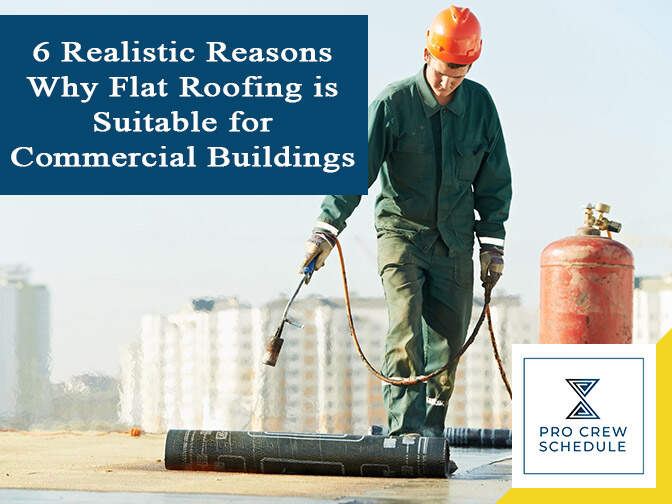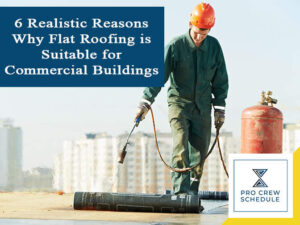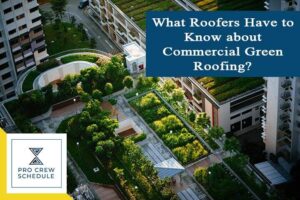Flat roofing has already been noticeable in most commercial buildings these days. An increasing number of clients, particularly business owners, slowly discover the benefits a flat roof can give in their commercial properties. For roofing professionals, they could benefit from the increasing number of clients. With that being said, to exert effort in finding the best materials for flat roofs is found very crucial as well, including the use of a construction schedule software for scheduling purposes.
This type of roofing has started ever since ancient times and has continued to be preferred by many individuals from various regions. This roofing isn’t only practical but also very cost-effective. In this blog, several convincing reasons will be outlined on why a flat roof is a practical choice and best for commercial properties. Additionally, a list of best flat roof materials will also be shared as a guide for roofers on choosing the right materials. Take a look below.
1. Flat Roof Has Curb Appeal
Most clients these days, either homeowners or building owners, always have a choice of going into aesthetics without really considering other important factors. Choosing an aesthetic for roofs usually only focus on its exterior appearance and not for quality. That is why better suggestions always come from roofing experts. Usually, if preferring to get a much lesser aesthetic and to focus more on having a durable roof for the property, flat roofing is the best option. The roofs are capable of not losing any curb appeal from where it is installed, which is also essential.
For roofing contractors assigned to install the flat roofs, the use of the best construction management software like Pro Crew Schedule is incredibly useful. Tracking, monitoring, field management, cloud-storage are some of the best features the software tool has offered. All built-in functionalities designed to help construction professionals in handling any projects and crew members.
2. Flat Roof is Economical
Flat roofing can be costly, nearly 80% per foot if the choice will be using materials that are high in quality. Nevertheless, it has been practically observed that most of the owners who have commercial buildings installed with flat roofs get almost 35 years average plus minimal maintenance. So, roofers have figured it out already that flat roofs are the best choice for commercial proprietors. It is the best option for those clients who wanted to increase their budget and preferred to use high-end materials for roofs.
Projects Managers not only figured out the best options for clients but also wise beyond their expertise. Getting updates from any latest construction trends has been consistent. Applying advanced methods, practices, and using software tools is one of many things they do to provide higher-quality services further. A project management software has proven to help contractors supervise all sorts of projects and all involved working teams.
3. Flat Roof provides Efficient Drainage Systems
One of the fantastic things a flat roof can offer is its space. The space provided by it has allowed an installation for an efficient and complicated rainwater removal system. These systems are proven to be generally immune in blockage issues. Furthermore, another option is also given and that includes drainage system installation. The system is installed to convert rain into water sources for the rooftops and the garden directly. The roofing system and drainage system are best installed in any commercial properties if roofing experts and plumbers used an advanced tool like the construction project management software. The tool is specifically used in project management, scheduling purposes, crew supervision, etc.
4. Flat Roof is excellent for Space Optimization
Another reason for selecting flat roofing for any commercial properties is that it allows the features to enlarge or maximize the area’s use. This type of roofs is found to be fitting for large top floors. In most cases, the flat roofs are being used for sky gardens and even swimming pools. The use of such roofs is entirely different for industrial purposes because it is usually used to set up HVAC systems and house ventilation. Installations in any of the systems are often complicated and because of its complexity, it might difficult to handle. That is why well-organized project management for construction projects is crucial. Thus, it becomes an immediate priority.
5. Flat Roof is Long Lasting and Durable
One of the many listed advantages of using flat roofs for commercial buildings is that it will last longer and is strongly sturdy. It is believed that the EDPM roof can offer over 200 years of guaranteed replacement at 80% per sq. ft. The same way as sloped roofs, flat roofing is also able to provide permanency and reliability. Roofing experts also make way for advanced software tools as it ultimately affects the project’s cycle and development in many advantageous ways. Construction scheduling software is proven to create a harmonious work environment and contribute to the crew’s productivity.
6. Flat Roof is Wind Resistant
There are many roofing types nowadays and it is the tilted roofs where flat roofs are usually being compared. The latter is much better from the slanted roofs for one practical reason and it is because flat roofs are more wind resistant. Resistance from the wind means there is lesser damage to occur. Wind will get blown at any angles. Expect also to have a lesser issue when it comes to breaks and cracks that usually form between separate tiles. Fortunately, flat roofs happen not to have any tiles.
Top 4 Flat Roofing Materials
Replacements for commercial roofs isn’t the same way as purchasing a new blend of coffee – making a particular decision like this is a big deal. Doing research could help you find the best materials for this roof and what fits the budget. Most of the marketplace has been crowded already with tons of options for roofing materials and it can be difficult to distinguish which one is better. Lifespan, ease of maintenance, bottom line price are the three main factors to consider when analyzing the roofing material type.
Today we are breaking down some of the most high-performing, high-quality roofing materials types for commercial buildings.
1. PVC
For many roofing projects, PVC roofing is definitely the preferred option by most roofers as they often suggested it to their clients. PVC is also known as the best flat roof material available on the market. PVC roofing is also somewhat costly compared to other single-ply roofing materials, yet it still offers various benefits when it comes to its price. First and foremost, the reinforced membrane can turn PVC roofs more resistant to any impact damage and possible cracks. Cracks usually shorten the lifespan of single-ply roofs and it is a good thing that PVC is capable of resisting it. PVC roofing is also very low maintenance and has a long lifespan. Another great thing about it is that it can lower the energy bills because of its reflective white color.
2. TPO
This roof material is very popular and also considered as the best type to install. Its advantages are that its decent lifespan can last between 10 to 20 years, and it is also an inexpensive roof type option. Additionally, the white-coat roofs are equipped with similar energy-saving properties like the PVC and compare with EPDM roofs; this roof type requires only lesser maintenance since the seams are already heat welded so that it can prevent any possible leaks.
3. Metal
A metal roof that is a commercial standing seam is usually ideal for buildings with rope greater than 2 inches. Metal is entirely different from most other roofing industrial material types for a couple of obvious reasons. Due to the nature of the material itself and the roofer’s installation process, metal is considered the most expensive roof type installed. Additionally, metal roofing typically has the most extended lifespan where it potentially lasts between 20 to 30 years. As metal being perceived as a durable material and has higher immunity from cracks, the only downside for this material is that it can be susceptible to leaks surrounding the edges of the roofs and the seams.
4. Modified Bitumen Roof
In comparison to other roofing materials for commercial properties, modified bitumen stood out from the rest. The reason behind is that it is more budget-friendly option. For these roofs, the main material to use is the asphalt membrane. Asphalt membranes are typically used as the main base of the roofs. The entire surface could possibly be susceptible to blisters and cracks and it usually becomes the downside of it. The typical lifespan of this roof is between 10 to 15 years. However, if the lifespan isn’t an issue; therefore, this roofing isn’t an issue. The price point alone could turn modified bitumen as one of the most practical options available.
Key Takeaways
As you finally understand why flat roofs are perfectly suitable for commercial properties, it’s a good thing to be always reminded that flat roofing fits into the business’s aesthetic requirements and needs and brings numerous advantages to its uses. Such a roof is proven to be very cost-effective and very durable. And by choosing any type of roofing material above, commercial roofs become extraordinarily functional and long-lasting.





